致密砂岩气地质特征与开发
- 格式:pdf
- 大小:3.27 MB
- 文档页数:59
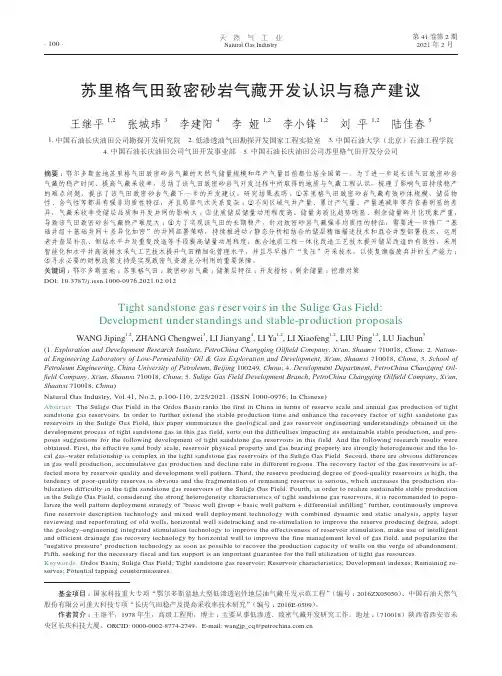
天 然 气 工 业Natural Gas Industry 第41卷第2期2021年 2月· 100 ·苏里格气田致密砂岩气藏开发认识与稳产建议王继平1,2 张城玮3 李建阳4 李娅1,2 李小锋1,2 刘平1,2 陆佳春51.中国石油长庆油田公司勘探开发研究院2.低渗透油气田勘探开发国家工程实验室3.中国石油大学(北京)石油工程学院4.中国石油长庆油田公司气田开发事业部5.中国石油长庆油田公司苏里格气田开发分公司摘要:鄂尔多斯盆地苏里格气田致密砂岩气藏的天然气储量规模和年产气量目前都位居全国第一。
为了进一步延长该气田致密砂岩气藏的稳产时间、提高气藏采收率,总结了该气田致密砂岩气开发过程中所取得的地质与气藏工程认识,梳理了影响气田持续稳产的难点问题,提出了该气田致密砂岩气藏下一步的开发建议。
研究结果表明:①苏里格气田致密砂岩气藏有效砂体规模、储层物性、含气性等都具有强非均质性特征,并且局部气水关系复杂;②不同区域气井产量、累计产气量、产量递减率等存在着明显的差异,气藏采收率受储层品质和开发井网的影响大;③优质储层储量动用程度高、储量劣质化趋势明显、剩余储量碎片化现象严重,导致该气田致密砂岩气藏稳产难度大;④为了实现该气田的长期稳产,针对致密砂岩气藏强非均质性的特征,需要进一步推广“基础井组+基础井网+差异化加密”的井网部署策略,持续推进动/静态分析相结合的储层精细描述技术和混合井型部署技术,运用老井查层补孔、侧钻水平井及重复改造等手段提高储量动用程度,配合地质工程一体化改造工艺技术提升储层改造的有效性,采用智能化和水平井高效排水采气工艺技术提升气田精细化管理水平,并且尽早推广“负压”开采技术,以恢复濒临废弃井的生产能力;⑤寻求必要的财税政策支持是实现致密气资源充分利用的重要保障。
关键词:鄂尔多斯盆地;苏里格气田;致密砂岩气藏;储集层特征;开发指标;剩余储量;挖潜对策DOI: 10.3787/j.issn.1000-0976.2021.02.012Tight sandstone gas reservoirs in the Sulige Gas Field:Development understandings and stable-production proposals WANG Jiping1,2, ZHANG Chengwei3, LI Jianyang4, LI Ya1,2, LI Xiaofeng1,2, LIU Ping1,2, LU Jiachun5(1. Exploration and Development Research Institute, PetroChina Changqing Oilfield Company, Xi'an, Shaanxi 710018, China;2. Nation-al Engineering Laboratory of Low-Permeability Oil & Gas Exploration and Development, Xi'an, Shaanxi 710018, China;3. School of Petroleum Engineering, China University of Petroleum, Beijing 100249, China;4. Development Department, PetroChina Changqing Oil-field Company, Xi'an, Shaanxi 710018, China;5. Sulige Gas Field Development Branch, PetroChina Changqing Oilfield Company, Xi'an, Shaanxi 710018, China)Natural Gas Industry, vol.41, No.2, p.100-110, 2/25/2021. (ISSN 1000-0976; In Chinese)Abstract: The Sulige Gas Field in the Ordos Basin ranks the first in China in terms of reserve scale and annual gas production of tight sandstone gas reservoirs. In order to further extend the stable production time and enhance the recovery factor of tight sandstone gas reservoirs in the Sulige Gas Field, this paper summarizes the geological and gas reservoir engineering understandings obtained in the development process of tight sandstone gas in this gas field, sorts out the difficulties impacting its sustainable stable production, and pro-poses suggestions for the following development of tight sandstone gas reservoirs in this field. And the following research results were obtained. First, the effective sand body scale, reservoir physical property and gas bearing property are strongly heterogeneous and the lo-cal gas–water relationship is complex in the tight sandstone gas reservoirs of the Sulige Gas Field. Second, there are obvious differences in gas well production, accumulative gas production and decline rate in different regions. The recovery factor of the gas reservoirs is af-fected more by reservoir quality and development well pattern. Third, the reserve producing degree of good-quality reservoirs is high, the tendency of poor-quality reserves is obvious and the fragmentation of remaining reserves is serious, which increases the production sta-bilization difficulty in the tight sandstone gas reservoirs of the Sulige Gas Field. Fourth, in order to realize sustainable stable production in the Sulige Gas Field, considering the strong heterogeneity characteristics of tight sandstone gas reservoirs, it is recommended to popu-larize the well pattern deployment strategy of "basic well group + basic well pattern + differential infilling" further, continuously improve fine reservoir description technology and mixed well deployment technology with combined dynamic and static analysis, apply layer reviewing and reperforating of old wells, horizontal well sidetracking and re-stimulation to improve the reserve producing degree, adopt the geology–engineering integrated stimulation technology to improve the effectiveness of reservoir stimulation, make use of intelligent and efficient drainage gas recovery technology by horizontal well to improve the fine management level of gas field, and popularize the "negative pressure" production technology as soon as possible to recover the production capacity of wells on the verge of abandonment. Fifth, seeking for the necessary fiscal and tax support is an important guarantee for the full utilization of tight gas resources. Keywords: Ordos Basin; Sulige Gas Field; Tight sandstone gas reservoir; Reservoir characteristics; Development indexes; Remaining re-serves; Potential tapping countermeasures基金项目:国家科技重大专项“鄂尔多斯盆地大型低渗透岩性地层油气藏开发示范工程”(编号:2016ZX05050)、中国石油天然气股份有限公司重大科技专项“长庆气田稳产及提高采收率技术研究”(编号:2016E-0509)。


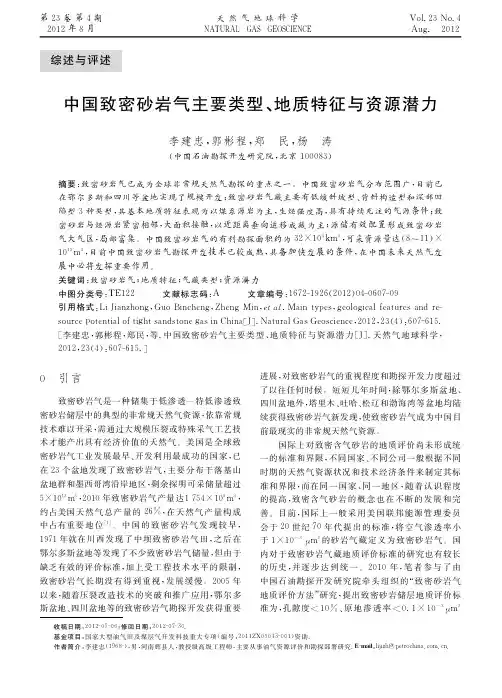
综述与评述收稿日期:2012-07-06;修回日期:2012-07-30.基金项目:国家大型油气田及煤层气开发科技重大专项(编号:2011ZX05043-001)资助.作者简介:李建忠(1968-),男,河南辉县人,教授级高级工程师,主要从事油气资源评价和勘探部署研究.E-mail:lijizh@petrochina.com.cn.中国致密砂岩气主要类型、地质特征与资源潜力李建忠,郭彬程,郑 民,杨 涛(中国石油勘探开发研究院,北京100083)摘要:致密砂岩气已成为全球非常规天然气勘探的重点之一。
中国致密砂岩气分布范围广,目前已在鄂尔多斯和四川等盆地实现了规模开发;致密砂岩气藏主要有低缓斜坡型、背斜构造型和深部凹陷型3种类型,其基本地质特征表现为以煤系源岩为主,生烃强度高,具有持续充注的气源条件;致密砂岩与烃源岩紧密相邻,大面积接触,以近距离垂向运移成藏为主;源储有效配置形成致密砂岩气大气区,局部富集。
中国致密砂岩气的有利勘探面积约为32×104km2,可采资源量达(8~11)×1012 m3,目前中国致密砂岩气勘探开发技术已较成熟,具备加快发展的条件,在中国未来天然气发展中必将发挥重要作用。
关键词:致密砂岩气;地质特征;气藏类型;资源潜力中图分类号:TE122 文献标志码:A 文章编号:1672-1926(2012)04-0607-09引用格式:Li Jianzhong,Guo Bincheng,Zheng Min,et al.Main types,geological features and re-source potential of tight sandstone gas in China[J].Natural Gas Geoscience,2012,23(4):607-615.[李建忠,郭彬程,郑民,等.中国致密砂岩气主要类型、地质特征与资源潜力[J].天然气地球科学,2012,23(4):607-615.]0 引言致密砂岩气是一种储集于低渗透—特低渗透致密砂岩储层中的典型的非常规天然气资源,依靠常规技术难以开采,需通过大规模压裂或特殊采气工艺技术才能产出具有经济价值的天然气。

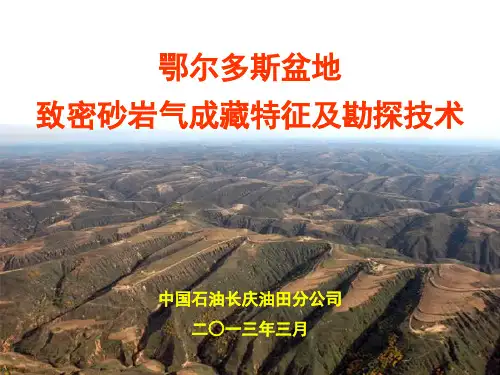

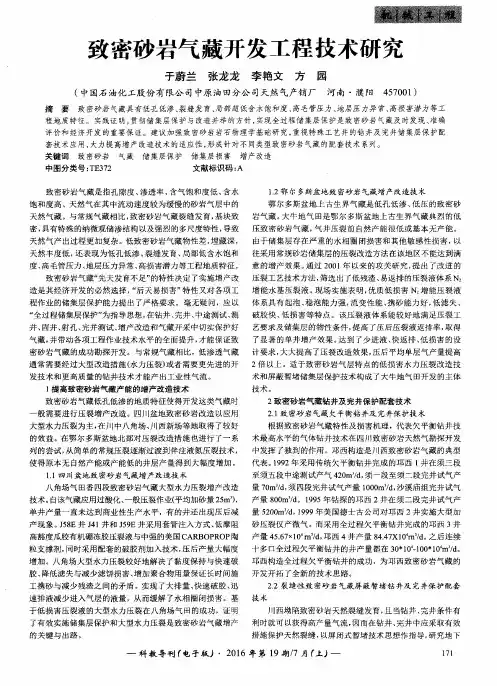
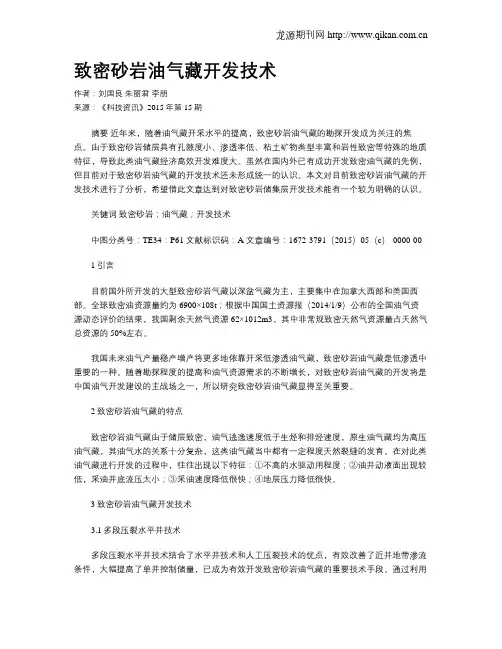
致密砂岩油气藏开发技术作者:刘国良朱丽君李朋来源:《科技资讯》2015年第15期摘要近年来,随着油气藏开采水平的提高,致密砂岩油气藏的勘探开发成为关注的焦点。
由于致密砂岩储层具有孔隙度小、渗透率低、粘土矿物类型丰富和岩性致密等特殊的地质特征,导致此类油气藏经济高效开发难度大。
虽然在国内外已有成功开发致密油气藏的先例,但目前对于致密砂岩油气藏的开发技术还未形成统一的认识。
本文对目前致密砂岩油气藏的开发技术进行了分析,希望借此文章达到对致密砂岩储集层开发技术能有一个较为明确的认识。
关键词致密砂岩;油气藏;开发技术中图分类号:TE34:P61 文献标识码:A 文章编号:1672-3791(2015)05(c)-0000-001引言目前国外所开发的大型致密砂岩气藏以深盆气藏为主,主要集中在加拿大西部和美国西部。
全球致密油资源量约为6900×108t;根据中国国土资源报(2014/1/9)公布的全国油气资源动态评价的结果,我国剩余天然气资源62×1012m3,其中非常规致密天然气资源量占天然气总资源的50%左右。
我国未来油气产量稳产增产将更多地依靠开采低渗透油气藏,致密砂岩油气藏是低渗透中重要的一种。
随着勘探程度的提高和油气资源需求的不断增长,对致密砂岩油气藏的开发将是中国油气开发建设的主战场之一,所以研究致密砂岩油气藏显得至关重要。
2致密砂岩油气藏的特点致密砂岩油气藏由于储层致密,油气逃逸速度低于生烃和排烃速度,原生油气藏均为高压油气藏,其油气水的关系十分复杂,这类油气藏当中都有一定程度天然裂缝的发育。
在对此类油气藏进行开发的过程中,往往出现以下特征:①不高的水驱动用程度;②油井动液面出现较低,采油井底流压太小;③采油速度降低很快;④地层压力降低很快。
3致密砂岩油气藏开发技术3.1多段压裂水平井技术多段压裂水平井技术结合了水平井技术和人工压裂技术的优点,有效改善了近井地带渗流条件,大幅提高了单井控制储量,已成为有效开发致密砂岩油气藏的重要技术手段。
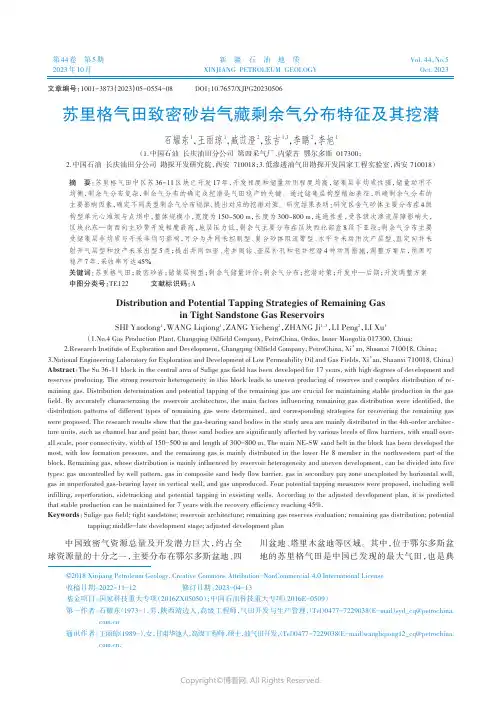
第44卷 第5期 新 疆 石 油 地 质Vol. 44,No.52023年10月 XINJIANG PETROLEUM GEOLOGY Oct. 2023文章编号:1001-3873(2023)05-0554-08 DOI :10.7657/XJPG20230506苏里格气田致密砂岩气藏剩余气分布特征及其挖潜石耀东1,王丽琼1,臧苡澄2,张吉1,3,李鹏2,李旭1(1.中国石油 长庆油田分公司 第四采气厂,内蒙古 鄂尔多斯 017300;2.中国石油 长庆油田分公司 勘探开发研究院,西安 710018;3.低渗透油气田勘探开发国家工程实验室,西安 710018)摘 要:苏里格气田中区苏36-11区块已开发17年,开发程度和储量动用程度均高,储集层非均质性强,储量动用不均衡,剩余气分布复杂,剩余气分布的确定及挖潜是气田稳产的关键。
通过储集层构型精细表征,明确剩余气分布的主要影响因素,确定不同类型剩余气分布规律,提出对应的挖潜对策。
研究结果表明:研究区含气砂体主要分布在4级构型单元心滩坝与点坝中,整体规模小,宽度为150~500 m ,长度为300~800 m ,连通性差,受各级次渗流屏障影响大,区块北东—南西向主砂带开发程度最高,地层压力低,剩余气主要分布在区块西北部盒8段下亚段;剩余气分布主要受储集层非均质与开采非均匀影响,可分为井网未控制型、复合砂体阻流带型、水平井未动用次产层型、直定向井未射开气层型和投产未采出型5类;提出井间加密、老井侧钻、查层补孔和老井挖潜4种动用措施,调整方案后,预测可稳产7年,采收率可达45%。
关键词:苏里格气田;致密砂岩;储集层构型;剩余气储量评价;剩余气分布;挖潜对策;开发中—后期;开发调整方案中图分类号:TE122 文献标识码:A©2018 Xinjiang Petroleum Geology. Creative Commons Attribution-NonCommercial 4.0 International License 收稿日期:2022-11-12 修订日期:2023-04-13基金项目:国家科技重大专项(2016ZX05050);中国石油科技重大专项(2016E-0509)第一作者:石耀东(1973-),男,陕西靖边人,高级工程师,气田开发与生产管理,(Tel )************(E-mail )syd_cq@通讯作者:王丽琼(1989-),女,甘肃华池人,高级工程师,硕士,油气田开发,(Tel )************(E-mail )wangliqiong12_cq@petrochina..Distribution and Potential Tapping Strategies of Remaining Gasin Tight Sandstone Gas ReservoirsSHI Yaodong 1,WANG Liqiong 1,ZANG Yicheng 2,ZHANG Ji 1,3,LI Peng 2,LI Xu 1(1.No.4 Gas Production Plant, Changqing Oilfield Company, PetroChina, Ordos, Inner Mongolia 017300, China;2.Research Institute of Exploration and Development, Changqing Oilfield Company, PetroChina, Xi ’an, Shaanxi 710018, China ;3.National Engineering Laboratory for Exploration and Development of Low Permeability Oil and Gas Fields, Xi ’an, Shaanxi 710018, China )Abstract :The Su 36⁃11 block in the central area of Sulige gas field has been developed for 17 years, with high degrees of development and reserves producing. The strong reservoir heterogeneity in this block leads to uneven producing of reserves and complex distribution of re⁃maining gas. Distribution determination and potential tapping of the remaining gas are crucial for maintaining stable production in the gas field. By accurately characterizing the reservoir architecture, the main factors influencing remaining gas distribution were identified, the distribution patterns of different types of remaining gas were determined, and corresponding strategies for recovering the remaining gas were proposed. The research results show that the gas⁃bearing sand bodies in the study area are mainly distributed in the 4th⁃order architec⁃ture units, such as channel bar and point bar, these sand bodies are significantly affected by various levels of flow barriers, with small over⁃all scale, poor connectivity, width of 150-500 m and length of 300-800 m. The main NE⁃SW sand belt in the block has been developed the most, with low formation pressure, and the remaining gas is mainly distributed in the lower He 8 member in the northwestern part of the block. Remaining gas, whose distribution is mainly influenced by reservoir heterogeneity and uneven development, can be divided into five types: gas uncontrolled by well pattern, gas in composite sand body flow barrier, gas in secondary pay zone unexploited by horizontal well, gas in unperforated gas⁃bearing layer in vertical well, and gas unproduced. Four potential tapping measures were proposed, including well infilling, reperforation, sidetracking and potential tapping in exsisting wells. According to the adjusted development plan, it is predicted that stable production can be maintained for 7 years with the recovery efficiency reaching 45%.Keywords :Sulige gas field; tight sandstone; reservoir architecture; remaining gas reserves evaluation; remaining gas distribution; potential tapping; middle-late development stage; adjusted development plan中国致密气资源总量及开发潜力巨大,约占全球资源量的十分之一,主要分布在鄂尔多斯盆地、四川盆地、塔里木盆地等区域。
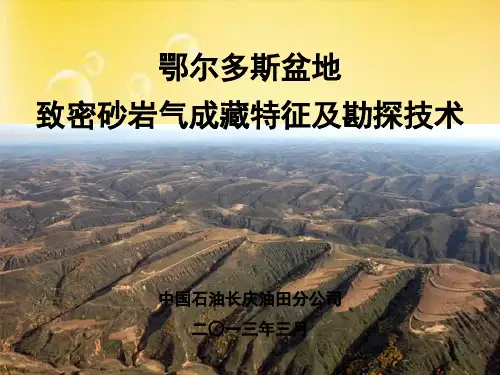
致密天然气砂岩储层成因和讨论随着全球能源需求的不断增长,天然气的地位越来越重要。
而致密天然气砂岩储层作为天然气的主要储藏之一,其成因和特征备受。
本文将致密天然气砂岩储层的成因作为主题,探讨形成该储层的主要因素及特征,旨在为相关领域的研究和应用提供参考。
致密天然气砂岩储层是指以砂岩为主要储集岩石,孔隙度较低,渗透率较低,储层压力较高的天然气储层。
致密天然气砂岩储层的成因类型主要包括沉积环境、成岩作用、构造运动和古气候等因素。
沉积环境是致密天然气砂岩储层形成的重要因素。
在一定的地质历史时期,特定的沉积环境导致砂岩沉积物的沉积方式和沉积厚度会影响砂岩储层的孔隙度和渗透率。
例如,在盆地中心和盆地边缘的砂岩沉积厚度较大,但孔隙度和渗透率较低,而在盆地边缘和斜坡上的砂岩沉积厚度较小,孔隙度和渗透率较高。
成岩作用也是致密天然气砂岩储层形成的重要因素。
在砂岩沉积后,会发生压实、胶结、重结晶等成岩作用,这些作用会改变砂岩的孔隙度和渗透率。
例如,压实作用会导致砂岩孔隙度降低,渗透率显著降低;胶结作用也会降低砂岩孔隙度,但渗透率降低程度较小;重结晶作用会改善砂岩的孔隙度,提高渗透率。
构造运动和古气候也是致密天然气砂岩储层形成的重要因素。
构造运动会影响砂岩的沉积环境和成岩作用,进而影响砂岩储层的孔隙度和渗透率。
古气候则会影响砂岩沉积物的成分和粒度,进而影响砂岩储层的孔隙度和渗透率。
致密天然气砂岩储层的成因是多方面的,主要包括沉积环境、成岩作用、构造运动和古气候等因素。
这些因素相互作用,共同影响着砂岩储层的特征和发育。
因此,在研究和应用致密天然气砂岩储层时,应该综合考虑这些因素,以期更加深入地了解该储层的特征和发育。
也需要注意保护环境,合理利用资源,实现可持续发展。
致密砂岩气藏是一种非常丰富的天然气资源,但由于其储层特征的复杂性和隐蔽性,使得致密砂岩气藏的储层识别和开发难度较大。
因此,研究致密砂岩气藏储层特征及有效储层识别方法对提高天然气开采效率和降低开发成本具有重要意义。
致密砂岩气调研提纲
一、致密砂岩气的定义及特征
1、致密砂岩气的定义
2、致密砂岩气藏的地质特征(圈闭特征、储层类型、地层压力、气水关系、气体相态)
3、致密砂岩气藏开发特征
二、致密砂岩气藏聚集机理及成藏过程特征
1、致密砂岩气田形成的控制因素
2、致密气聚集机理
3、致密砂岩气成藏过程及特征
4、我国致密砂岩气藏及主要分布
三、致密砂岩气藏储层特征
1、储层地质特征及分类
2、储层成因与主要控制因素
3、储层评价技术
四、低渗透致密砂岩气藏渗流规律及开发机理
1、储层微观孔隙特征
2、应力敏感性分析
3、滑脱效应
4、启动压力
5、气水两相渗流规律
6、气藏工程方法
7、单井动态储量计算
8、气藏可动性研究及储量评价
五、致密砂岩气藏储层气水分布规律研究
1、气、水层识别方法及研究
2、气、水运移微观渗流机理(不同含水饱和度下气、水渗流规律)
3、宏观、微观条件下可动水饱和度的变化
4、储层产水机理研究(初始含水饱和度、束缚水饱和度、可动水饱和度、水的渗流能
力等影响因素)
六、低渗透致密砂岩气藏开发优化及提高采收率技术
1、储层改造技术(酸化压裂技术等)
2、提高采收率技术(井网密度、气井类型、气井工作制度、气井废弃压力)
3、致密砂岩气藏水平井开发技术
4、国外布井规律,在断层处布井
(富集区优选、井位优选、开发方式优化、密井网、控压开采、合理配产、压裂酸化、加强储层保护、强化排水采气、增压开采)。
致密砂岩气储量标准一、储量估算致密砂岩气储量估算是在对致密砂岩气藏进行详细勘探的基础上,通过对气藏储层、盖层和保存条件等进行详细研究和分析,结合现代地球物理和地质勘查技术手段,对气藏的储量和规模进行科学估算。
二、储层描述致密砂岩储层是致密砂岩气藏的重要组成部分,其描述包括以下方面:1.储层岩石学特征:主要描述储层岩石的矿物组成、粒度、磨圆度、分选性等特征。
2.储层物性特征:主要描述储层的孔隙度、渗透率、含气饱和度等物性参数。
3.储层含气性特征:主要描述储层中天然气的类型、含量、丰度等特征。
4.储层保存条件:主要描述储层的构造、岩性、热流等地质条件对天然气的保存和运移的影响。
三、气藏特征致密砂岩气藏是一种特殊的天然气藏,其特征包括以下方面:1.气藏压力高:致密砂岩气藏一般具有较高的气藏压力,需要采用特殊的高压开采技术。
2.气藏产量低:由于致密砂岩储层的孔隙度和渗透率较低,气藏的产量相对较低。
3.开发难度大:由于致密砂岩气藏具有较高的压力和较低的产量,开发难度较大,需要采用特殊的开采技术和设备。
4.经济价值高:由于致密砂岩气藏的天然气品质较好,价格较高,因此具有较高的经济价值。
四、资源品质致密砂岩气的资源品质主要取决于天然气的组成和含量。
一般来说,致密砂岩气的组成比较单一,主要成分是甲烷,含量较高,具有较高的热值和较低的杂质含量,因此是一种优质的清洁能源。
此外,致密砂岩气还具有较高的碳氢比和较低的含氧量,这些特征都表明致密砂岩气具有较高的资源品质。
五、储量规模致密砂岩气的储量规模是衡量其开发价值的重要指标之一。
一般来说,致密砂岩气的储量规模较大,但由于其储层物性较差,产量较低,因此需要采用特殊的开采技术和管理措施来提高采收率。
此外,致密砂岩气的开发还需要考虑地质风险、技术条件、经济成本等因素的影响,因此需要结合具体情况进行综合评估。
六、开发方案致密砂岩气的开发方案需要根据具体情况进行制定。
一般来说,开发方案需要考虑以下因素:1.地质特征:包括气藏的压力、温度、组成等特征。
中国致密砂岩气开发工程技术与实践马新华;贾爱林;谭健;何东博【摘要】Tight sand gas is the main type of unconventional natural gas. According to the geologic characteristics of large-scale tight sandstone gas reservoirs discovered in China in recent years, tight sand gas reservoirs can be classified into three main types, multi-layer lens overlaid tight sand gas reservoir, multilayered tight sandstone gas reservoir and massive tight sand gas reservoir. A series of development technologies for the first 2 types of reservoirs have been formed, focusing on improving individual well producing rate and reducing development cost. They drive the scale development of tight gas. As to multi-layer lens overlaid tight sand gas, the specific technologies include well location optimization, multi-stage sand fracturing, down hole choking and low-pressure surface gas gathering system. As to multilayered tight sand gas, the specific technologies include sweet-spot prediction and evaluation, integrated horizontal well development technique, and drainage gas recovery technique. There are still great challenges in tight gas development from several aspects, such as the enhancement of reserve deployment ratio and recovery ratio, the improvement of individual well producing rate, the development of new and difficult-to-produce reserves as well as the rate maintenance, and gas well management in its later stage of life cycle.%致密砂岩气是非常规天然气的主要类型.根据中国近年来发现的大型致密砂岩气藏的开发地质特征,可划分为3种主要类型:透镜体多层叠置致密砂岩气、多层状致密砂岩气及块状致密砂岩气.前2种类型以提高单井产量、降低开发成本为技术目标形成了系列开发技术,推动了致密气的规模化发展.针对透镜体多层叠置致密砂岩气,形成了以优化布井、多级加砂压裂、井下节流与低压地面集输为特点的开发技术.针对多层状致密砂岩气,形成了以富集区预测与评价、水平井整体开发和排水采气为特点的开发技术.中国致密砂岩气具有广阔的发展前景,但仍面临诸多技术挑战,包括提高储量动用程度和采收率、进一步提高单井产量、新类型和难动用储量的开发、气田稳产接替与开发后期气井管理等.【期刊名称】《石油勘探与开发》【年(卷),期】2012(039)005【总页数】8页(P572-579)【关键词】致密砂岩气;分类评价;开发工程技术系列;技术挑战【作者】马新华;贾爱林;谭健;何东博【作者单位】中国石油勘探与生产公司;中国石油勘探开发研究院;中国石油勘探与生产公司;中国石油勘探开发研究院【正文语种】中文【中图分类】TE132.2致密砂岩气是非常规天然气的主要类型,也是目前国际上开发规模最大的非常规天然气,在天然气资源结构中的意义和作用日趋显著。